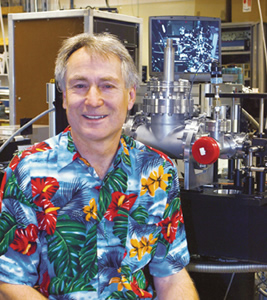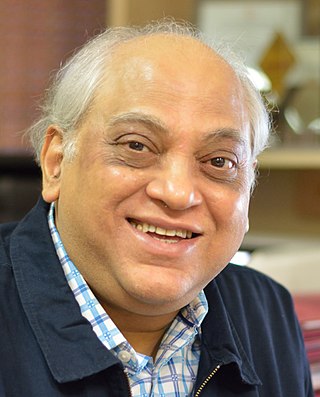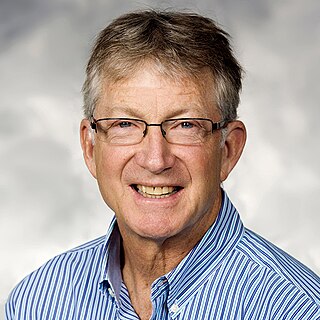
Sir Alan Roy Fersht is a British chemist at the MRC Laboratory of Molecular Biology, Cambridge, and an Emeritus Professor in the Department of Chemistry at the University of Cambridge. He was Master of Gonville and Caius College, Cambridge from 2012 to 2018. He works on protein folding, and is sometimes described as a founder of protein engineering.
John Norman Abelson is an American molecular biologist with expertise in biophysics, biochemistry, and genetics. He was a professor at the California Institute of Technology (Caltech).

William Esco Moerner, also known as W. E. Moerner, is an American physical chemist and chemical physicist with current work in the biophysics and imaging of single molecules. He is credited with achieving the first optical detection and spectroscopy of a single molecule in condensed phases, along with his postdoc, Lothar Kador. Optical study of single molecules has subsequently become a widely used single-molecule experiment in chemistry, physics and biology. In 2014, he was awarded the Nobel Prize in Chemistry.
Tobin Jay Marks is an inorganic chemistry Professor, the Vladimir N. Ipatieff Professor of Catalytic Chemistry, Professor of Material Science and Engineering, Professor of Chemical and Biological Engineering, and Professor of Applied Physics at Northwestern University in Evanston, Illinois. Among the themes of his research are synthetic organo-f-element and early-transition metal organometallic chemistry, polymer chemistry, materials chemistry, homogeneous and heterogeneous catalysis, molecule-based photonic materials, superconductivity, metal-organic chemical vapor deposition, and biological aspects of transition metal chemistry.
Christopher David Garner FRSC FRS is a British retired chemist, whose research work was in the growing field of Biological Inorganic Chemistry. His research primarily focussed on the role of transition metal elements in biological processes, for which he published over 400 original papers and reviews on the topic. His specific interests lie in the roles of Molybdenum and Tungsten as the metal centres in various enzyme cofactors based on the molybdopterin molecule.

Richard James Saykally is an American chemist. He is currently the Class of 1932 Endowed Professor of Chemistry at the University of California, Berkeley. He has received numerous awards for his research on the molecular characteristics of water and aqueous solutions.
Edward I. Solomon is the Monroe E. Spaght Professor of Chemistry at Stanford University. He is an elected member of the United States National Academy of Sciences, a Fellow of the American Association for the Advancement of Science, and a Fellow of the American Academy of Arts and Sciences. He has been profiled in the Proceedings of the National Academy of Sciences. He has also been a longtime collaborator with many scientists, including Professor Kenneth D. Karlin at Johns Hopkins University.

Martin Gruebele is a German-born American physical chemist and biophysicist who is currently James R. Eiszner Professor of Chemistry, Professor of Physics, Professor of Biophysics and Computational Biology at the University of Illinois Urbana-Champaign, where he is the principal investigator of the Gruebele Group.

Amitabha Chattopadhyay is an Indian scientist working in the areas of membrane and receptor biology and biophysics. He is presently a CSIR Bhatnagar Fellow at the Center for Cellular and Molecular Biology and served as the founding dean of biological sciences at the Academy of Scientific and Innovative Research (AcSIR). In addition, he is a distinguished visiting professor at the Indian Institute of Technology Bombay, adjunct professor at the Jawaharlal Nehru University, Tata Institute of Fundamental Research, Indian Institute of Science Education and Research (Kolkata), Swinburne University of Technology (Australia), and honorary professor at the Jawaharlal Nehru Centre for Advanced Scientific Research (Bangalore). He was elected a Fellow of the Royal Society of Chemistry in 2013 and Royal Society of Biology in 2017. Chattopadhyay has authored more than 300 research papers and has an h-index of 65.
Ch. Mohan Rao is an Indian molecular biologist. He holds a Ph.D. in chemistry from the University of Hyderabad. He was a visiting associate at the National Institutes of Health, US, during 1990–92. He was a visiting professor at the Tokyo Science University, Japan during 1996. Visiting Scientist, UTMB, Galveston, USA, Visiting Professor, Protein Research Institute, Osaka, Japan. Adjunct Professor, RMIT University, Melbourne, Australia. He was positioned as director for the Centre for Cellular and Molecular Biology in Hyderabad, India. He is CSIR-Distinguished Scientist and Sir JC Bose National Fellow at CCMB He was awarded in 1999 the Shanti Swarup Bhatnagar Prize for Science and Technology, the highest science award in India, in the Medical Sciences category.

Lai-Sheng Wang is an experimental physical chemist currently serving as the Chair of the Chemistry Department at Brown University. Wang is known for his work on atomic gold pyramids and planar boron clusters.
Dipankar Das Sarma, popularly known as D.D. Sarma, is an Indian scientist and structural chemist, known for his researches in the fields of Solid State Chemistry, Spectroscopy, Condensed Matter Physics, Materials Science, and Nanoscience. He is a former MLS Chair Professor of Physics and Chairman of the Centre for Advanced Materials and the GAST Professor of Uppsala University, Sweden, A recipient of TWAS Physics Prize and the UNESCO Biennial Javed Husain Prize, Sarma was honored by the Council for Scientific and Industrial Research (CSIR), Government of India, in 1994, with the Shanti Swarup Bhatnagar Prize for Science and Technology.

Jane Clarke is an English biochemist and academic. Since October 2017, she has served as President of Wolfson College, Cambridge. She is also Professor of Molecular Biophysics, a Wellcome Trust Senior Research Fellow in the Department of Chemistry at the University of Cambridge. She was previously a Fellow of Trinity Hall, Cambridge. In 2023, she was elected to the National Academy of Sciences.
Marvin H. Caruthers is an American biochemist who is a distinguished professor at the University of Colorado Boulder.
Paul Gassman was an American chemist. He is best known for his research in the field of organic chemistry and his service as president of the American Chemical Society and is listed among notable alumni by the Cornell University Graduate School.

William Michael Gelbart is Distinguished Professor of Chemistry and Biochemistry at the University of California, Los Angeles, and a member of the California NanoSystems Institute and the UCLA Molecular Biology Institute. He obtained his Bachelor of Science degree from Harvard University in 1967, his Master's (1968) and PhD (1970) degrees from the University of Chicago, and did postdoctoral work at the University of Paris (1971) and the University of California, Berkeley (1972). After 30 years of research in theoretical physical chemistry, contributing notably to the fields of gas-phase photophysics, optical properties of simple liquids, and the statistical physics of complex fluids, he started a biophysics laboratory with Charles Knobler in 2002 to investigate the physical aspects of viral infectivity.

Gary M. Hieftje is an analytical chemist, Distinguished Professor, and the Robert & Marjorie Mann Chair of Chemistry at Indiana University in Bloomington, Indiana. Gary M. Hieftje received his A.B. degree at Hope College in Holland, Michigan in 1964, and his PhD from University of Illinois at Urbana–Champaign in 1969. In 1969, he started his career in teaching and research at Indiana University. Hieftje was named a Distinguished Professor in 1985, and entered emeritus status in 2018. As of 2018, Dr. Hieftje has been involved in over 600 publications.
Christine "Christy" Chow is a professor of chemistry and former associate dean of the College of Liberal Arts and Sciences at Wayne State University. She works on modified RNAs, RNA-ligand interactions and RNA therapeutics. She is a Fellow of the American Chemical Society (ACS).

James L. Skinner is an American theoretical chemist. He is the Joseph O. and Elizabeth S. Hirschfelder Professor Emeritus at the University Wisconsin-Madison. He is also a member of the Scientific Advisory Board of the Welch Foundation. Most recently, Skinner was the Crown Family Professor of Molecular Engineering, professor of chemistry, director of the Water Research Initiative and deputy dean for faculty affairs of the Pritzker School of Molecular Engineering at the University of Chicago. Skinner is recognized for his contributions to the fields of theoretical chemistry, nonequilibrium statistical mechanics, linear and nonlinear spectroscopy of liquids, amorphous and crystalline solids, surfaces, proteins, and supercritical fluids. Skinner is the co-author of over 230 peer-reviewed research articles.
John Philip Simons is a British physical chemist known for his research in photochemistry and photophysics, molecular reaction dynamics and the spectroscopy of biological molecules. He was professor of physical chemistry at the University of Nottingham (1981–93) and Dr. Lee's Professor of Chemistry at the University of Oxford (1993–99).









